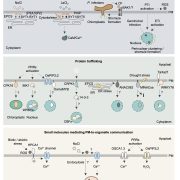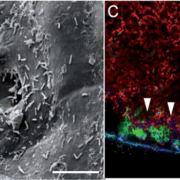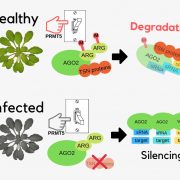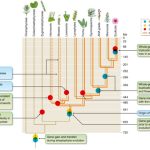Review: Improving RNA-based crop protection through nanotechnology and insights from cross-kingdom RNA trafficking
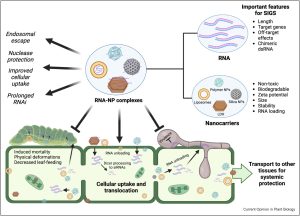 The German physician Paul Ehrlich (not to be confused with the American scientist of the same name) coined the term “magic bullet” (zauberkugel) to describe something that is perfectly and accurately effective. As much as we dream of magic bullets, they are rarely found, but the idea of using spray-on RNA as an agent of pest control seems pretty close. Here, Chen et al. review progress in this field, specifically spray-induced gene silencing (SIGS), and particularly the use of nanotechnology to improve its efficacy. The potential for small RNAs to specifically and effectively silence target genes has been recognized for decades; the challenges in pest control are largely about delivery and stability. The authors review examples of naturally occurring cross-kingdom RNAi, particularly the involvement of extracellular vesicles in enabling movement. Delivery and stability are greatly increased by the encapsulation of the RNA into nanoparticles of various design and composition (including layered double hydroxide clay nanosheets, chitosan, carbon-based materials, liposomes, and star polycations). There’s an interesting discussion about how the nanoparticles enter the plant, and translocation within the plant tissues, and efforts to improve these. Before widely adopted, the fate of the nanocarriers in the environment and impacts on non-target organisms needs to be addressed. Nevertheless, the appeal of spraying on droplets of encapsulated, highly targeted small RNAs as a means of crop protection is real. (Summary by Mary Williams @PlantTeaching) Curr. Opin. Plant Biol. 10.1016/j.pbi.2023.102441
The German physician Paul Ehrlich (not to be confused with the American scientist of the same name) coined the term “magic bullet” (zauberkugel) to describe something that is perfectly and accurately effective. As much as we dream of magic bullets, they are rarely found, but the idea of using spray-on RNA as an agent of pest control seems pretty close. Here, Chen et al. review progress in this field, specifically spray-induced gene silencing (SIGS), and particularly the use of nanotechnology to improve its efficacy. The potential for small RNAs to specifically and effectively silence target genes has been recognized for decades; the challenges in pest control are largely about delivery and stability. The authors review examples of naturally occurring cross-kingdom RNAi, particularly the involvement of extracellular vesicles in enabling movement. Delivery and stability are greatly increased by the encapsulation of the RNA into nanoparticles of various design and composition (including layered double hydroxide clay nanosheets, chitosan, carbon-based materials, liposomes, and star polycations). There’s an interesting discussion about how the nanoparticles enter the plant, and translocation within the plant tissues, and efforts to improve these. Before widely adopted, the fate of the nanocarriers in the environment and impacts on non-target organisms needs to be addressed. Nevertheless, the appeal of spraying on droplets of encapsulated, highly targeted small RNAs as a means of crop protection is real. (Summary by Mary Williams @PlantTeaching) Curr. Opin. Plant Biol. 10.1016/j.pbi.2023.102441



